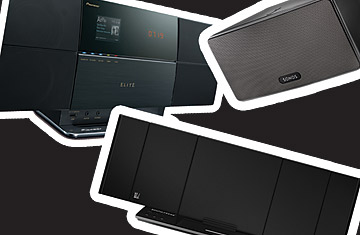
Clockwise from top left: Pioneer Music Tap, Sonos Play:3, Soundfreaq Sound Stack
The iPod has always had a reputation for ushering in an era of musical selfishness. Apple seems to be O.K. with that perception. Remember the iPod ads that showed silhouetted figures wearing those iconic white earbuds, rocking out while blocking out the world?
Me, I still think it's a bum rap. The wealth of music that the iPod — and the iPhone and the iPad and Android handsets and similar gadgets — puts in your pocket isn't just for solitary listening. If you have a means of pumping it through a decent set of speakers, it's at least as much fun to share as it is to hog it for yourself.
Hardware makers have always understood this and have long manufactured a dizzying array of audio systems for the iPod and its offspring and rivals. You can buy one for $20 or for $550,000. (Yes, $550,000.) Or you could find a middle ground, such as Soundfreaq's Sound Stack, Pioneer's Music Tap and Sonos' Play:3. The Play:3 doesn't actually play music directly from smart phones and other mobile gadgets, although it works with both Apple and Android devices and the result is similar — more about that in a bit.
All these products are in the same price range. The Sonos is $299, and the Sound Stack and Music Tap are $399. They're all petite enough to be at home in nearly any room and can stream music wirelessly rather than requiring you to futz with cables or connectors. And to my nonaudiophile eardrums, they all sound nice. Yet each takes its own approach. They're less direct competitors than alternate takes on how wireless music should work.
First, the Sound Stack. It's a handsome, low-slung unit that's a bit less than a foot and a half wide, with a facade of black cloth and just a few touch-sensitive controls, plus an optical input for connecting to boxes like game consoles and a USB port for charging phones and other devices. Inside there are two full-range drivers and two subwoofers, in a configuration Soundfreaq calls DubSub. In my tests, the combination produced audio that sounded as if it were emanating from a larger, fancier rig.
The system has an FM tuner but no display to show you what station you're on; you control the radio with an app available in iOS and Android versions. There's also a dock connector that lets you plug in an iPod, iPhone, iPod Touch or iPad — even one ensconced in a case — for charging and listening. But docking any of these devices isn't as nifty as streaming music wirelessly to the Sound Stack, a feat you can also perform with an Android phone.
The Sound Stack accomplishes this using Bluetooth, a technique that has several virtues. When everything goes right, setup is a snap: I was listening to music from an iPhone 4S less than five minutes after tugging the speaker out of its Styrofoam — a speed record that neither the Pioneer nor the Sonos competed with. Bluetooth also lets you stream virtually any audio source from almost any Bluetooth-enabled gizmo.
Bluetooth's reality doesn't always live up to its theoretical goodness, though. I had trouble getting a Verizon Fascinate phone to interface with the Sound Stack and am currently checking in with Soundfreaq for troubleshooting assistance. Bluetooth has one other catch: it was designed primarily to transmit data for wee hops, like the distance from the smart phone in your pocket to the headset in your ear. Soundfreaq says it works for distances "up to" 33 feet, but your experience will vary, depending on your home's layout and other factors. As long as I stayed in the same room as the Sound Stack, the music streamed flawlessly; if I absentmindedly wandered into the one across the hallway, it sputtered, then conked out altogether.
There is a simple way for a wireless speaker maker to avoid Bluetooth's limited range: it can use more powerful wi-fi networking instead. That's the approach that Pioneer emphasizes in its Music Tap systems, which are available in a $399 version and the one I tested, a slightly more upscale $479 Elite variant. Both are a skosh bigger than the Soundfreaq but still tabletop-friendly. They contain two active drivers and generally sounded pleasing, if occasionally a bit more shrill than the Soundfreaq and Sonos.
The Elite has Bluetooth built in, and it's available on the cheaper Music Tap using an adapter. Both versions also have a dock connector that works with iPhones and iPods but not iPads. It cleverly pops out like a CD tray when you need it and stays out of the way otherwise. Those are secondary connectivity options, though. The Music Tap's signature feature is its support for Apple's AirPlay technology, which lets it use Wi-Fi to stream audio from many iPhone/iPod Touch/iPad apps. With Android devices, the Music Tap can use DLNA, a similar but clunkier technology that's bundled with many (but not all) devices and can provide access to music stored on computers and drives on your network.
I liked AirPlay, except for one minor irritant: when I pressed the Pause button on the iPhone, there was a noticeable lag before the music did, in fact, pause. (I'd jab at it needlessly, unsure whether my input had registered.)
Even if your Apple or Android gadget's battery dies, you won't be left unentertained by the Music Tap. Using a service called Vtuner, it provides direct access to 16,000 free Internet radio stations, including an embarrassment of music in every genre and news from around the planet. You can put music files on a thumb drive, then stick it into the Music Tap's USB port for listening. There's FM. And AM.
